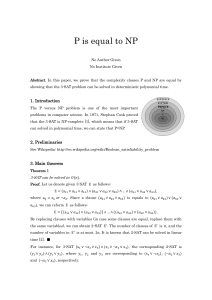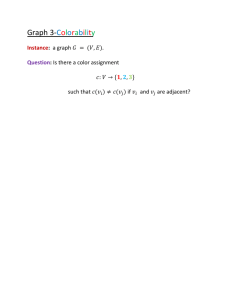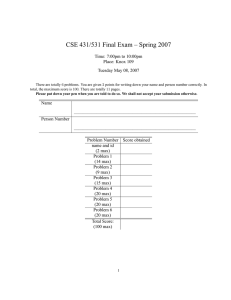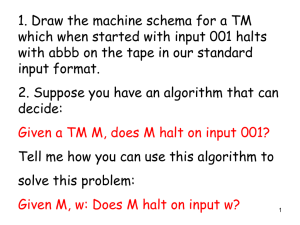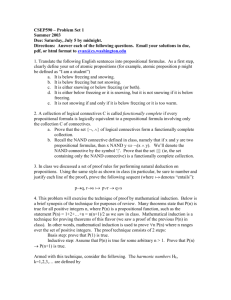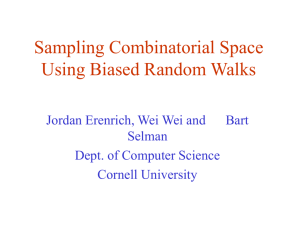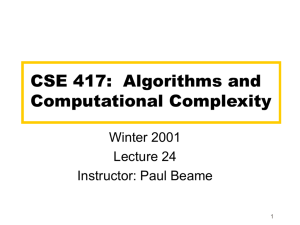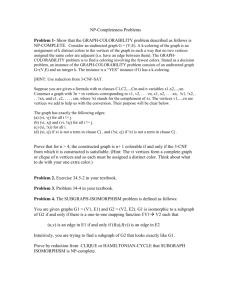Physical Manifestation of NP-Completeness in ... Computing Devices Frank Lee
advertisement
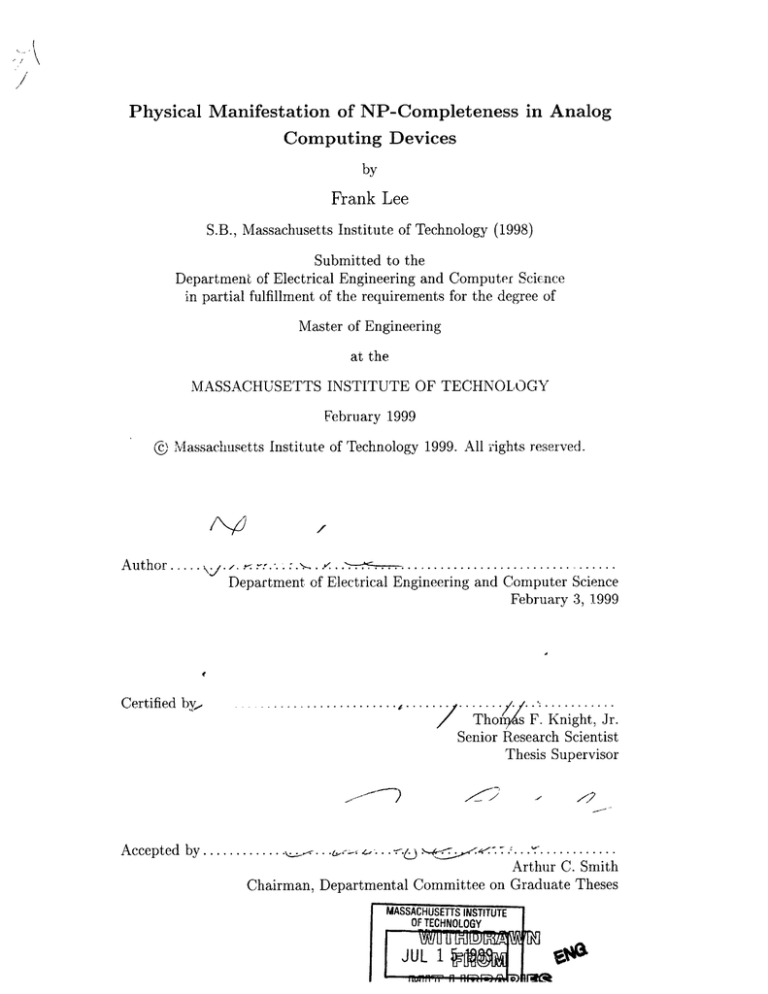
Physical Manifestation of NP-Completeness in Analog
Computing Devices
by
Frank Lee
S.B., Massachusetts Institute of Technology (1998)
Submitted to the
Department of Electrical Engineering and Computer Science
in partial fulfillment of the requirements for the degree of
Master of Engineering
at the
MASSACHUSETTS INSTITUTE OF TECHNOLOGY
February 1999
(c) Massachusetts Institute of Technology 1999. All rights reserved.
Author .....
...
.-.-.
.
.. ..
. . . .. .. . . . . . . . . . . . . . . . . . . . . . . . . . . . . ..
Department of Electrical Engineering and Computer Science
February 3, 1999
Certified by,
.........
....
........ ...
* ........
. ..
.q........... ...
/
s F. Knight, Jr.
Tho
Senior Research Scientist
Thesis Supervisor
Accepted by............-..
.-.
............
....
Arthur C. Smith
Chairman, Departmental Committee on Graduate Theses
MASSACHUSETTS INSTITUTE
OF TECHNOLOGY
JUL 1
2
Physical Manifestation of NP-Completeness in Analog Computing
Devices
by
Frank Lee
Submitted to the Department of Electrical Engineering and Computer Science
on February 3, 1999, in partial fulfillment of the Requirements for the degree of
Master of Engineering
Abstract
In 1986, Vergis, Steiglitz, and Dickinson proposed a mechanical analog computer to solve
NP-hard problems where the amount of computing time needed could theoretically be made
as small as possible if the machine works as designed. They proceeded to argue using Strong
Church's Thesis and the hypothesis of P : NP that the machine must malfunction when
operated, although no detailed physical analysis was done to determine what would be the
exact cause of failure. This thesis analyzes the machine at an implementation-independent
block-diagram level and points out two fundamental flaws in the design.
Thesis Supervisor: Thomas F. Knight, Jr.
Title: Senior Research Scientist
3
Acknowledgments
First and foremost, I thank my advisor Tom Knight for supporting me through this effort,
and for providing me with my first research experiences via the MIT Undergraduate Research
Opportunities Program. One of these experiences led to this thesis. I've learned a great
deal from my conversations with him. He has a way of getting to the heart of the matter
very quickly, and places great emphasis on clear, succinct explanation.
I am eternally grateful to my mom and dad for their love and support, and for the efforts
they made to provide a peaceful environment where I could get a college education, do
research, and contemplate. They were also my first source of funding, providing me with
the means to procure the electronic components, tools, books, and software needed to build
my first electronics projects.
Special thanks go to my brother Arthur, MIT Class of 1985. He has always been generous
in sharing with me his years of wisdom and experience. Throughout my childhood, he
helped kindle my interests in mathematics and the physical sciences. He introduced me
to algebra, coordinate geometry, trigonometry, and calculus, well before these topics were
covered in my schoolwork. He bought me an electronics project kit from Radio Shack when
he first saw my interest in taking apart radios. I'll always be thankful for his foresight in
working afterschool, weekends, and summers to save up money to buy an Apple ] [+ personal
computer in 1979. That machine provided me with my first computer experiences while I
was still in kindergarten, and my first computer programming experiences when I entered
second grade.
I'd like to acknowledge certain people who provided additional support and guidance during
various crucial moments of my career at the Institute. Special thanks go to Jim Bales at
the Edgerton Center, Jacky Mallett at the Media Lab, George Verghese of EECS, and Anne
Hunter at the Course VI Undergraduate Office.
Last but not least, I thank my friends for making things fun throughout my school years.
In particular I should mention (in alphabetical order): Mike Jacknis, Peter Leung, James
Lin, and Janis Stipins. I'd also like to thank the people on the 6th floor of Ashdown House
for making the dorm such a cool place to return to after a long day.
This research was supported by DARPA (the Defense Advanced Research Projects Agency of
the United States of America) as part of the Scalable Computing Systems research program,
under contract number DABT63-95-C-0130.
4
to our curiosity
5
s...-w...a-...
3,.,_,....,..,.......,..,
-. s--ree.,....
s.-,,.,,.,
-.
...
......
s..,.
,,..,s.,.y.,...,
6
Mu..---e-T
ei s'-.-r5--.s maar-:--n
,,_,,,.
,.s,.,,.r..:.
.
-. '01:.
-- :
,-
---
.
.s.-.
-
,,...
.. ,4--s
.,
-s
'.1..wl..osaur.;-s,.....-<.s.a.is.....<0,-...:..,,..*..,,........,,
.,..
_,
_
..
..
.
-is-,.
-- ... ....,... .-.
,...r.--.,.w..,1....
.1.1-- +r..no
....,.. . ..,_,
,.
...
. -.>..s
Contents
1
2
9
Introduction& background
1.1
The Goal of the Thesis . . . . . . . . . . . . . . . . . . . . . . . . . . . . . . .
9
1.2
Background . . . . . . . . . . . . . . . . . . . . . . . . . . . . . . . . . . . . .
9
1.3
The argument for machine failure . . . . . . . . . . . . . . . . . . . . . . . . . 10
1.4
Motivation for the present work . . . . . . . . . . . . . . . . . . . . . . . . . . 10
1.5
Vergis' Algorithm to convert a 3-SAT instance to a machine . . . . . . . . . . 11
1.6
3-SAT Machine Design Rationale . . . . . . . . . . . . . . . . . . . . . . . . . 12
. . . . . . . . . . . . . . . . . . . . . . . . . . . . . 12
1.6.1
Some terminology
1.6.2
The 3-SAT instance shapes the machine's feasible space . . . . . . . . 14
1.6.3
Physical exploration of a mathematical space . . . . . . . . . . . . . . 14
1.6.4
Intended functioning of the 3-SAT machine . . . . . . . . . . . . . . . 14
17
Analysis of the machine
2.1
The difficulty in analyzing the 3-SAT machine . . . . . . . . . . . . . . . . . . 17
2.1.1
Digital computing machines are easy to simulate and analyze . . . . . 17
2.1.2
Digital computing elements have well-defined inputs and outputs . . . 17
2.1.3
Whereas the elements of the 3-SAT machine are bidirectional . . . . . 18
2.1.4
They enforce constraints, but how? . . . . . . . . . . . . . . . . . . . . 18
7
CONTENTS
8
2.1.5
. . . . . . . . 18
2.2
O ur focus . . . . . . . . . . . . . . . . . . . . . . . . . . . . . . . . . . . . . . 19
2.3
Two fundamental flaws in the 3-SAT machine's design . . . . . . . . . . . . . 19
2.4
3
Only the shape of the machine's state space is specified
2.3.1
Squarers can jam . . . . . . . . . . . . . . . . . . . . . . . . . . . . . . 19
2.3.2
The amazing properties of perfectly rigid shafts . . . . . . . . . . . . . 20
Conclusion
References
. . . . . . . . . . . . . . . . . . . . . . . . . . . . . . . . . . . . . 21
23
9
Chapter 1
Introduction & background
1.1
The Goal of the Thesis
In 1986, Vergis, Steiglitz, and Dickinson proposed a mechanical analog computer to solve
NP-complete problems where the amount of computing time needed could theoretically be
made as small as possible if the machine works as designed [Vergis86]. They proceeded to
argue using Strong Church's Thesis and the hypothesis of P $ NP that the machine must
malfunction when operated, although no detailed physical analysis was done to determine
what would be the exact cause of failure. The goal of my thesis is to analyze the physical
operation of the machine and determine using physical arguments why it does not work.
1.2
Background
In 1986, Anastasios Vergis, Kenneth Steiglitz, and Bradley Dickinson proposed a class of
mechanical devices that can be used to solve 3-SAT, a well-known NP-complete problem.
The authors then used widely held principles and beliefs in computer science to argue that
these machines could never work, because if they did, it would be possible to solve NPcomplete problems within polynomial time, using only polynomial quantities of machine
parts and a good machine shop. This would throw into doubt either the belief that P $ NP,
or the widely-held strengthened interpretation of the Church-Turing Thesis - that the P
and NP class hierarchy is invariant over all physically-realizable computing machines. This
has been referred to in the literature as "Strong Church's Thesis" [Vergis86].
This debunking of the proposed machine is in the same spirit as the instinctive, 5-second
dismissal of proposed perpetual motion machines by invoking the laws of thermodynamics.
But there is a difference. The principles of thermodynamics have proven themselves over
more than a century of intense developments in engineering, physics, chemistry, and biology.
The P $ NP statement, on the other hand, only expresses a belief of computer scientists who
10
Chapter 1. Introduction & background
have worked but failed for decades to either show that P = NP or find a polynomial-time
algorithm for an NP-complete problem [Garey79]. It has not been proven that P # NP.
Also the Strong Church's Thesis has not been tested exhaustively enough to be held at the
same level of confidence and broad applicability as thermodynamic laws such as conservation
of energy. For instance, recent work in quantum computing suggests the P and NP classes
for quantum computers may differ from those of classical ones [Shor97]. We will, however,
restrict our discussion to classical computers, and hold the Strong Church's Thesis to say
that the P and NP class hierarchy is invariant over all classical computing machines.
1.3
The argument for machine failure
Assume the 3-SAT machine does work and solves 3-SAT using polynomial resources (time,
energy, force). By Strong Church's Thesis, any digital computer can simulate any analog
one by expending a quantity of computing effort that is at most a polynomial function of the
resources used by the analog device. A digital computer running a simulation of the 3-SAT
machine would thus be able to solve 3-SAT within polynomial time. But this contradicts
the hypothesis that P $ NP. Therefore the assumption that the 3-SAT machine works must
be false - the 3-SAT machine does not work.
1.4
Motivation for the present work
The line of reasoning in the Vergis paper raises issues intersecting physics and computer
science. The authors were able to use the major theoretical ideas in computer science of
Church's Thesis and P $ NP to say something about how a physical machine should or
should not work, without the need to study the detailed mechanism of the machine to
see why. This could inspire, among other things, future attempts at disproving machines
through the argument "If that machine really worked, it would mean P = NP, which is
dubious, thus it is unlikely that machine really works."
There may be a fundamental physical principle at work. The principles of thermodynamics
were founded on the experimental fact that no successful perpetual motion machines have
ever been built. Analogously, there may be physical principles, discovered or undiscovered,
that correspond to the notions of Church's Thesis and whether or not P is a proper subset
of NP.
This thesis takes the first step into this line of inquiry by providing a detailed analysis of
the operation of the Vergis-Steiglitz-Dickinson 3-SAT machine (henceforth referred to as the
"3-SAT machine") with the goal of isolating the exact failure mechanism.
1.5.
1.5
Vergis' Algorithm to convert a 3-SAT instance to a machine
11
Vergis' Algorithm to convert a 3-SAT instance to a
machine
Start with the instance of 3-SAT to be solved. For example:
Given boolean variables X 1 , X 2 , X 3 , X 4 . Does there exist an assignment of truth values to
these variables that will cause all the clauses listed below to be true?
X1 + T
2 + X4
X2 + X3 + X 4
X 1 + X 2 +y 3
X 2 + X3 + X4
The following procedure is applied to the 3-SAT instance to create a machine:
1. Define real variables x
1
1,x
1 2 , X3 ,
2
3,
X 4 ,x 4 , i.e., one real variable for each un-
negated boolean one, and one real variable for each negated boolean variable. Also
define a real variable xO.
2. Convert all the boolean clauses in the 3-SAT instance to inequalities by changing all
boolean variables to their corresponding real variables, and by reinterpreting all +
signs to mean addition instead of logical-or. Append the symbols > xo to the right of
each converted clause to form inequalities.
3. The result is:
X1
+
T2
+
X4 > zO
X 2 + T3 + 4 > zO
T 1 + X 2 + 3 XzO
T2 + X3 + T4 > zO
We will call these inequalities Real 3-SAT clauses.
4. The relationship enforced between each x, and Yj is
2
F5x + 3Yj
zi -F(
4
0
>0
where F is defined as
F(w)
2
if w > 0
if w < 0
< 0
differentiable for all w
=w
5. Build a machine out of gears, shafts, squarers, cams (for F), differentials, and limit
stops that implements these equations as kinematic constraints. An example schematic
diagram for such a machine is given below. Initialize all the xi's and Yi's to zero.
Chapter 1. Introduction & background
12
Torque the xo shaft in the positive direction. If the shaft moves, the 3-SAT instance
is satisfiable, else it is not.
1.6
1.6.1
3-SAT Machine Design Rationale
Some terminology
The 3-SAT machine has many moving parts - the exact number of moving parts is proportional to the sum of the number of clauses and the number of variables in the 3-SAT
problem from which it was derived. Any motion of the machine will involve the coordinated
motion of many of these parts. It is important that we establish a common terminology for
discussing these complex motions.
First, we need a way of describing the machine's current position or state. The machine's
current state can be captured by listing the angular displacements of all of the machine's
shafts. If there are N shafts, then we need a list of N numbers. In general, the positions of
N shafts lie in an N-dimensional space RN. We call this the state space of the machine.
A machine motion can be described as a line or curve or path through state space. Each
coordinate axis of the space corresponds to a unique shaft in the machine. Given a machine
motion that is described as a path through state space, the movement of any particular
shaft of the machine is the projection of the path onto that shaft's axis in state space.
Often, shaft motions are not independent of each other. Some shafts are so rigidly coupled
to others that knowing the displacement of one of them is always enough to indicate the
displacements of the others. For example, knowing the angular displacement of just one of
the gears in a gear train is enough to allow one to determine the angular displacements of
all the gears in the train, if the axles of the gears are all fixed with respect to one another.
For any machine made of gears, shafts, differentials, cams, and limit stops all mounted on
the same rigid frame, there is a minimum number of shafts whose displacements one must
know to be able to figure out the displacements of all shafts in the machine. This number
is called the number of degrees of freedom of the machine.
The numbers x 0 , xi, and Yi, i E {1, 2,3,... ,n} in the equations generated by Vergis'
Algorithm each represent shaft displacements. n is the number of variables in the 3-SAT
instance that mapped to the machine. While there may be more than 2n + 1 shafts in
any practical implementation of the machine, these shafts taken together are the fewest
necessary to represent all the machine's degrees of freedom. This makes it possible to
capture the configuration of the machine with a state space of dimension 2n + 1.
The equations generated by Vergis' Algorithm tell us which machine configurations are allowed and disallowed. Only those points in state space that satisfy the kinematic constraints
generated by the algorithm correspond to allowed configurations of the machine. The set of
all allowed configurations is called the feasible space of the machine.
13
1.6. 3-SAT Machine Design Rationale
x
xo
Xb
Xa
>0
F(w)
Xc
= w2
if w> 0
if w < 0
<0
differentiable for all w
>0
The Clause mechanism
The x : T mechanism
Directional convention: Viewed from the top or from the left, clockwise rotation is (+).
X1
xo
X3
I
czzzzl
) Clause 1
Clause 2
ID
Clause 3
) Clause n
x:x
x:x
x:x
Example schematic layout of the 3-SAT machine
14
Chapter 1. Introduction & background
For example, consider a simple machine: the differential gear. It is a device with 3 shafts,
which we'll label x, y, and z. The differential gear enforces the relationship
z = Xz+ y.
Some examples of legal configurations are (x, y, z) = (0, 0, 0), (1, 0, 1), (-1, 1, 0), (2, 3, 5), and
(-3,1, -2). An example of an illegal configuration is (x, y, z) = (3, 2, 1), because 3 + 2 # 1.
1.6.2
The 3-SAT instance shapes the machine's feasible space
The goal of any 3-SAT problem is to determine whether a set of Boolean clauses can be
satisfied simultaneously. Vergis' Algorithm translates 3-SAT problems into equations defining the feasible space of a machine, where the shape of the feasible space has a particular
property if and only if the 3-SAT problem is satisfiable.
The particular property is whether or not the origin of the feasible space (i.e., all xi's and
Ti's set to zero) is a local maximum for x0 . Equivalently, when starting from the origin,
is it possible to move to any point where x0 > 0 such that, along the way, x0 is strictly
increasing? A proof in Vergis' paper which we will recount below establishes the following
correspondence: If the instance of 3-SAT is satisfiable, then the origin is not a local maximum
for x0 . Otherwise, the origin is a local maximum for x 0 .
The shape of any feasible space can be explored mathematically: we can guess points in
the state space and check them against the equations to see if they satisfy. With enough
guesses, we can map out the shape of the space, learn whether the origin maximizes x0 and
thus discover whether the corresponding 3-SAT instance is satisfiable or not. Since 3-SAT
is NP-complete, this guess-and-try method will take exponential time.
1.6.3
Physical exploration of a mathematical space
The idea of the 3-SAT machine is to embody these equations physically in the workings of
a machine. Each part of the machine acts to enforce part of the constraints imposed by
the equations. The hope is that physical exploration of the space will be faster than any
guess-and-try approach. It doesn't look like the machine has to move very much to compute
and report its result. The machine is exploring a local property of its starting point. The
parts of the machine are reasonably simple. It looks like the machine could work, and yet
we know that it can't.
1.6.4
Intended functioning of the 3-SAT machine
As described in Vergis' Algorithm, to operate the machine, all shafts are initially set to zero.
This corresponds to the machine starting at the origin of its feasible space. Then the xo
shaft is torqued in the positive direction. This xo shaft will either move or not.
15
1.6. 3-SAT Machine Design Rationale
If the 3-SAT instance that mapped to the machine is satisfiable, then the machine can move. This is because there is at least one path through feasible space that
starts from the origin and progresses monotonically to arbitrarily large positive values of xo.
This path can be constructed from knowledge of a satisfying assignment A to the 3-SAT
problem, using this procedure:
For each i E {1,... , n} where n is the number of 3-SAT variables: If Xi = TRUE in A
then set xi = 3xo and TI = -xo, otherwise (Xj = TRUE, so) set xi = -xo and Tj = 3xo.
Then for all xo > 0 this is a valid path. A satisfying assignment ensures each 3-SAT clause
has at least one variable that's TRUE, so correspondingly, the left-hand side of each Real
3-SAT clause is guaranteed to have at least one term equal to 3xo. Since the other 2 terms
can sum to no less than -2xo, it is clear that the left-hand side of each Real 3-SAT clause
equals or exceeds xO, satisfying the inequality.
To complete the proof that the path is feasible, we must check the relationships between
each xi and its Ti. First, notice that enforcing
x2
z -FF
5xi+ 3T
4
>0
>
is equivalent to enforcing
-i xi
- -3xi
for x, > 0
for x <0
Each pair (xi, Tj) is either assigned the values (3xo, -zo) or the values (-xo, 3xo). In either
case the relationships hold, hence the path is feasible, and hence the machine can move
when the xO shaft is driven.
If the machine moves, then the 3-SAT instance is satisfiable. If the machine moves,
then xO must have moved off the origin onto a positive value. Since all left-hand sides of
the Real 3-SAT clauses must equal or exceed xO, each left-hand side must be positive. This
means at least one term on each left-hand side must be positive, since the sum of 3 negative
numbers cannot possibly make a positive number. Examine the machine to find out which
terms are positive and which are negative. For each xi that is positive set the corresponding
3-SAT Xi = TRUE, and for each Yj that is positive set Xi = FALSE. The relationship
enforced between x and Yj ensure that both can't be positive, preventing the absurdity of
setting Xi = Ti.
Net result: The machine moves if and only if the 3-SAT instance is satisfiable.
16
Chapter 1. Introduction & background
17
Chapter 2
Analysis of the machine
2.1
2.1.1
The difficulty in analyzing the 3-SAT machine
Digital computing machines are easy to simulate and analyze
The step-by-step time-evolution of conventional digital and analog machines is easy to analyze. Conventional digital machines such as personal computers, workstations, calculators,
and embedded controllers are all essentially networks of logic gates (such as NANDs, NORs,
and inverters) and memory elements (such as latches, flip-flops, and SRAM/DRAM cells).
Each logic gate and memory element has clear and well-defined inputs and outputs. Upon a
change in input, any change in output occurs within a fixed finite time. All possible inputs
and their corresponding outputs are listed in truth tables and timing diagrams.
In principle, we could figure out exactly what any digital computer will do by writing down
the state of all of its memory elements at a given instant. Then we figure out what is at
the inputs of every logic gate. We start with those gates whose inputs are connected to the
outputs of memory elements. The rest is a straightforward process of table-lookups since
the truth-tables of all of these gates are known. Eventually, we figure out what is at the
inputs of the memory elements, and from that, we know what the state of these memory
elements will become next. The process can be repeated to reveal the following state, ad
infinitum.
2.1.2
Digital computing elements have well-defined inputs and outputs
The logic gates in conventional digital computers have well-defined input and output ports.
The op-amps and integrators in electronic analog computers also have well-defined input
and output ports. Signals at the input ports of these gates affect and determine what signals
18
Chapter 2. Analysis of the machine
are produced at the output ports. Signals at the output ports, however, don't cause these
devices to produce signals at their input ports.
2.1.3
Whereas the elements of the 3-SAT machine are bidirectional
The shafts attached to the gear couplings, differentials, and smooth cams in a 3-SAT machine
don't share this property. No port on any of these components can be considered strictly
an input or strictly an output. It is possible to drive a gear coupling either way: A 2:1
gear coupling, driven one way, can be used to output half the drive speed. Driven the other
way, it outputs twice the drive speed. In either case, the gear coupling acts to maintain a
2:1 relationship in shaft speed and rotational displacement. The components in a 3-SAT
machine thus act to enforce constraints or maintain mathematical relationships among the
rotational displacements of the machine's shafts.
2.1.4
They enforce constraints, but how?
Since the elements of the 3-SAT machine don't have clearly-defined inputs and outputs, it
isn't obvious or likely we can simulate the machine's time-evolution with the same degree
of ease and certainty as with digital machines. All we know about these elements is which
mathematical constraints they enforce among their shafts. The machine design specifies
what each element must accomplish, but not how it should go about doing it.
To begin to figure out the exact trajectory of a 3-SAT machine, we need to solve its set
of kinematic equations to map out the feasible space. Certain types of equations, e.g. sets
of linear equations, are quite easy to solve. Equations involving nonlinear terms are much
harder to solve, often requiring search, iterative, and approximation techniques whose computing time cannot be fixed or even predicted in advance. The 3-SAT machine's kinematic
equations fall into the nonlinear category due to the inclusion of the squarers.
But even with a map of the feasible space, we still know nothing about the trajectory
of the machine's motion. Knowing how each element goes about enforcing its constraint
would enable the formulation of differential equations which can be integrated to find the
trajectory. Knowing only what each element enforces can only reveal to us the set of all
possible trajectories.
2.1.5
Only the shape of the machine's state space is specified
A further difficulty: The 3-SAT machine is specified as a set of equations over the reals
which define the feasible state space of the machine. A given feasible space can be implemented countless ways - mechanically, electrically [Main94], electromechanically, and
someday maybe even chemically or biologically. Any real-world system that can host a multidimensional state space over the reals can potentially be used to build 3-SAT machines.
Yet the machine's dynamics will vary with choice of implementation technology.
2.2. Our focus
2.2
19
Our focus
To render the problem tractable, we will narrow our focus to a particular implementation
of the 3-SAT machines - the one suggested in Vergis' paper: a mechanical implementation
using gears, shafts, differential gears, smooth cams to make squarers, and limit stops. Even
so, the problem is still underspecified. To calculate the exact trajectory of the machine
through state space requires knowledge of the masses of the machine parts, coefficients of
friction, and details of the construction of the cams and differentials.
A balance must be struck between specifying the machine precisely enough to permit analysis
and drowning in a flood of details. This thesis will focus on what we can learn about the
motion of the machine given only a block-diagram description that shows only the kinematic
constraints enforced by each block. We give up trying to compute trajectories in favor of
looking at implementation-independent behaviors. We will assume we know nothing about
the masses and moments of inertia of the parts, or the coefficients of friction of the machine
parts.
Our goal: Given this simplified, underspecified machine model, what can we say about the
motion of the 3-SAT machines?
2.3
2.3.1
Two fundamental flaws in the 3-SAT machine's design
Squarers can jam
The squarers and the F-function cams are the only nonlinear devices in the machine. Since
the F-function cam acts the same as a squarer for all nonnegative inputs, much of what we
say about the squarers will apply to them.
The squarer is a two-shaft device which constrains the rotational displacement of one of its
shafts to be the square of the displacement of the other.
y
= z2
It works bidirectionally, meaning it is also possible to drive the y-shaft and transmit torque
to the x-shaft.
When the 3-SAT machine is initialized, all shafts are set at zero. At this point, the squarer
is no longer bidirectional, since if the y-shaft is turned, the differential amount that the
x-shaft is supposed to turn is
-x
dy
=x,y=O
_
dx
=d
x,y=O
-x
dx
= -x,y=o
2x x,y=o
=100.
20
Chapter 2. Analysis of the machine
This means the mechanical advantage against the turning is infinitely great - the squarer's
shafts will not turn at all. This jam cannot be overcome by applying more force. It is
very much like trying to push a solid block squarely against a flat frictionless wall. The
applied force is completely countered by the normal force of the wall. (The more usual
case of finite mechanical advantage is analogous to pushing a solid block against a wall at
a non-normal angle - the force applied will have a component that is parallel to the wall,
and that component will serve to move the object.)
This is a good candidate for a failure mechanism because it occurs regardless of the properties
of the materials used to make the machine. It is an inherent property of any machine that
implements the squaring function. Since the 3-SAT machine depends on its components
functioning in a bidirectional way to enforce constraints, the fact that its squarers aren't
bidirectional when it starts out casts doubt on the machine's functioning.
2.3.2
The amazing properties of perfectly rigid shafts
Another point of failure is the machine's dependence on perfectly rigid components. Such
components, which don't exist in the physical world, have some amazing properties. If one
end of a perfectly rigid shaft is torqued, that torque is conveyed instantaneously to the the
other end. The entire shaft turns in unison. The shaft motion can be considered a signal it can convey energy and information to a receiver. Here, the signals propagate at infinite
speed. This is a violation of Einstein's theory of special relativity, which sets an upper
bound on the speed of signal propagation in our universe. Indeed, any physical material has
an upper bound for the propagation of mechanical disturbances. It is the speed of sound in
that material.
The 3-SAT machine can be thought of as a group of mechanisms that communicate via
shaft motions. In zero time, the shafts pool together information from all mechanisms
about the constraints on each variable. This impossibly tight cooperation, if only it could
exist physically, may indeed allow the machine to work.
The design of the 3-SAT machine implicitly assumes perfectly rigid parts because each shaft's
angular displacement is described as a single number in the kinematic constraints generated
by Vergis' Algorithm. A more physically realistic shaft would act like a transmission line for
torsional waves. Its angular displacement cannot be captured by a single number. Instead,
angular displacement must be described as a function of time and position along the shaft.
Each infinitesimal segment of the shaft can have its own angular displacement with some
amount of independence. The material constraints on these angular displacement functions
can probably be represented as (partial differential) wave equations. In any case, the state
space of the machine will be of much higher dimensionality than our simple block-diagram
model would suggest.
Without instantaneous communication, it is unclear just how long it takes the 3-SAT machine to work. It likely that when the machine is started, a cacophony of torsional vibrations will result, rippling throughout the machine as the various clause mechanisms and
variable management mechanisms assert their presence asynchronously, fighting to enforce
2.4. Conclusion
21
their constraints. As torsional disturbances richochet through the device, partially-formed
trial solutions to the 3-SAT instance are being tested and rejected by mechanism after mechanism. We can speculate that during this computational process, an observer might hear
loud creaking sounds akin to wrenching metal.
2.4
Conclusion
The 3-SAT machine will not work for two reasons. One is its reliance on infinite-bandwidth
communications between its parts, something which cannot exist under the known laws
of our universe. The other is its dependence on the bidirectionality of its components,
coupled with the fact that the squaring devices in its mechanism fundamentally can never
be bidirectional.
22
Chapter 2. Analysis of the machine
23
Chapter 3
References
Garey and Johnson, Computers and Intractability: A Guide to the Theory of NP Completeness, Freeman, San Francisco, 1979. A standard reference and introduction to
the field of NP-completeness.
Michael G. Main "Analog Solution of NP-hard Problems", Department of Computer Science of University of Colorado at Boulder Technical Report CU-CS-700-94, Jan. 1994.
This paper describes an electronic implementation of the 3-SAT machine.
Peter W. Shor "Polynomial-Time Algorithms for Prime Factorization and Discrete Logarithms on a Quantum Computer", SIAM Journalon Computing, vol. 26, no. 5, pp.
1484-1509. While neither prime factorization or computing discrete logarithms have
been shown to be NP-complete, they are considered problems of such computational
complexity that they form the basis of modern cryptographic systems.
Vergis, Steiglitz, Dickinson, "The Complexity of Analog Computation", Mathematics
and Computers in Simulation, vol. 28, 1986, pp. 91-113. This is the source paper
describing the 3-SAT machine.
